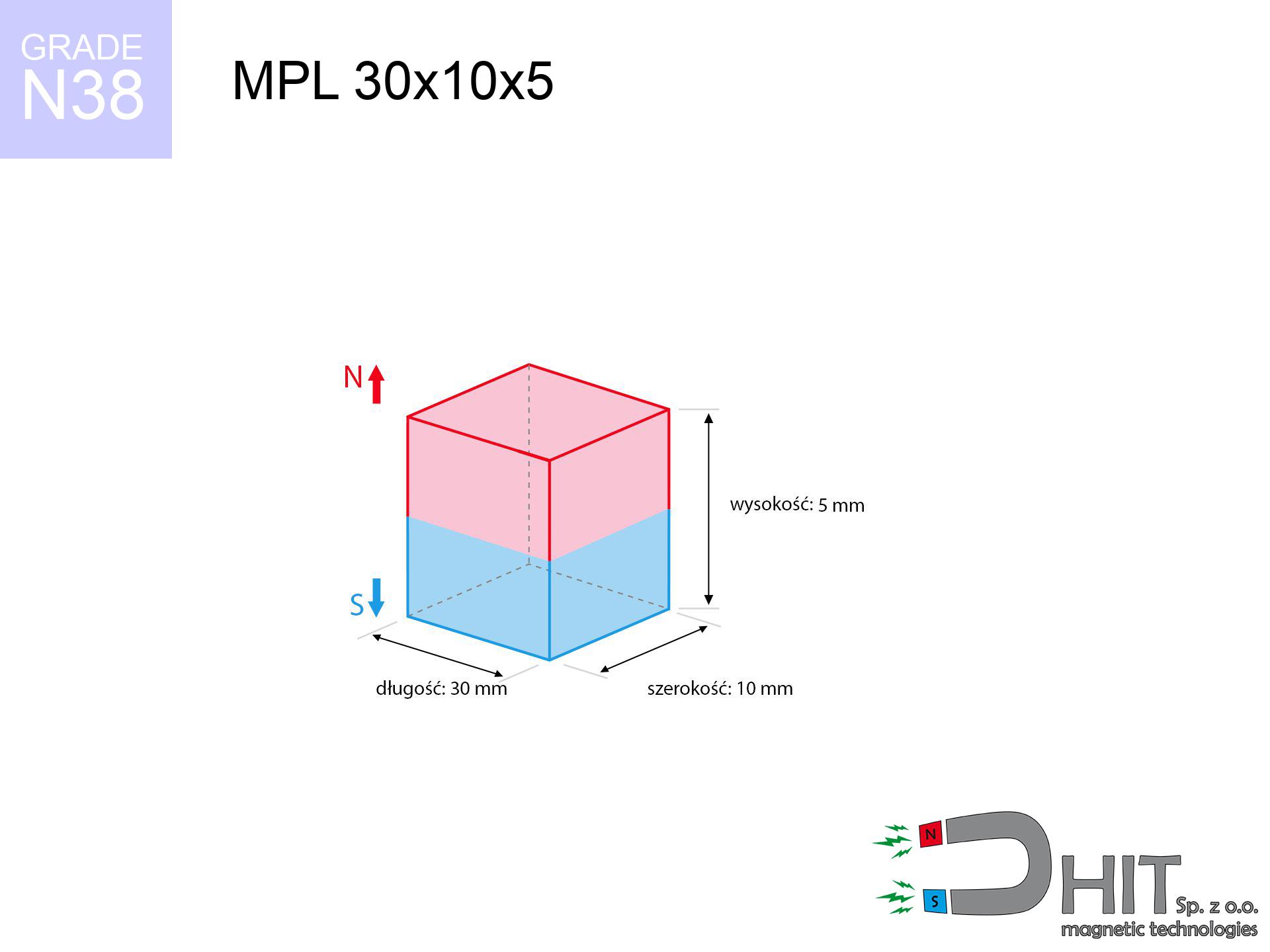MPL 30x10x5 / N38 - lamellar magnet
lamellar magnet
Catalog no 020138
GTIN: 5906301811442
length [±0,1 mm]
30 mm
Width [±0,1 mm]
10 mm
Height [±0,1 mm]
5 mm
Weight
11.25 g
Magnetization Direction
↑ axial
Load capacity
6.84 kg / 67.08 N
Magnetic Induction
329.52 mT
Coating
[NiCuNi] nickel
4.26 ZŁ with VAT / pcs + price for transport
3.46 ZŁ net + 23% VAT / pcs
bulk discounts:
Need more?Want to negotiate?
Call us
+48 888 99 98 98
if you prefer send us a note through
contact form
the contact page.
Parameters along with appearance of magnets can be analyzed with our
force calculator.
Same-day shipping for orders placed before 14:00.
Magnetic properties of material N38
Physical properties of sintered neodymium magnets Nd2Fe14B at 20°C
Shopping tips
Advantages and disadvantages of NdFeB magnets.
Besides their exceptional pulling force, neodymium magnets offer the following advantages:
- They retain attractive force for nearly ten years – the drop is just ~1% (based on simulations),
- Neodymium magnets are characterized by highly resistant to demagnetization caused by magnetic disturbances,
- Thanks to the elegant finish, the layer of nickel, gold, or silver-plated gives an visually attractive appearance,
- They feature high magnetic induction at the operating surface, which improves attraction properties,
- Made from properly selected components, these magnets show impressive resistance to high heat, enabling them to function (depending on their form) at temperatures up to 230°C and above...
- In view of the possibility of free molding and customization to specialized solutions, magnetic components can be produced in a wide range of forms and dimensions, which increases their versatility,
- Significant place in innovative solutions – they are utilized in computer drives, brushless drives, precision medical tools, as well as modern systems.
- Thanks to their power density, small magnets offer high operating force, occupying minimum space,
Disadvantages of NdFeB magnets:
- At very strong impacts they can crack, therefore we recommend placing them in strong housings. A metal housing provides additional protection against damage and increases the magnet's durability.
- When exposed to high temperature, neodymium magnets experience a drop in power. Often, when the temperature exceeds 80°C, their power decreases (depending on the size, as well as shape of the magnet). For those who need magnets for extreme conditions, we offer [AH] versions withstanding up to 230°C
- When exposed to humidity, magnets usually rust. For applications outside, it is recommended to use protective magnets, such as those in rubber or plastics, which prevent oxidation and corrosion.
- Limited ability of creating nuts in the magnet and complex forms - preferred is casing - magnet mounting.
- Possible danger to health – tiny shards of magnets can be dangerous, when accidentally swallowed, which gains importance in the context of child health protection. Furthermore, small elements of these products can be problematic in diagnostics medical after entering the body.
- High unit price – neodymium magnets are more expensive than other types of magnets (e.g. ferrite), which increases costs of application in large quantities
Optimal lifting capacity of a neodymium magnet – what affects it?
The load parameter shown concerns the limit force, measured under optimal environment, namely:
- using a plate made of low-carbon steel, functioning as a circuit closing element
- whose transverse dimension reaches at least 10 mm
- characterized by lack of roughness
- with direct contact (without impurities)
- during pulling in a direction perpendicular to the mounting surface
- at room temperature
What influences lifting capacity in practice
Effective lifting capacity impacted by specific conditions, including (from most important):
- Gap between surfaces – every millimeter of distance (caused e.g. by varnish or unevenness) significantly weakens the pulling force, often by half at just 0.5 mm.
- Force direction – declared lifting capacity refers to pulling vertically. When attempting to slide, the magnet holds significantly lower power (often approx. 20-30% of nominal force).
- Wall thickness – thin material does not allow full use of the magnet. Part of the magnetic field penetrates through instead of generating force.
- Plate material – mild steel attracts best. Alloy admixtures decrease magnetic properties and lifting capacity.
- Surface condition – ground elements ensure maximum contact, which increases force. Rough surfaces weaken the grip.
- Operating temperature – NdFeB sinters have a sensitivity to temperature. At higher temperatures they lose power, and at low temperatures they can be stronger (up to a certain limit).
* Lifting capacity testing was carried out on plates with a smooth surface of optimal thickness, under a perpendicular pulling force, in contrast under attempts to slide the magnet the load capacity is reduced by as much as 75%. In addition, even a small distance {between} the magnet and the plate decreases the holding force.
Warnings
Protective goggles
NdFeB magnets are sintered ceramics, meaning they are very brittle. Collision of two magnets will cause them breaking into shards.
Hand protection
Pinching hazard: The pulling power is so great that it can cause blood blisters, crushing, and broken bones. Protective gloves are recommended.
Magnetic media
Avoid bringing magnets close to a wallet, computer, or screen. The magnetism can destroy these devices and wipe information from cards.
Medical implants
Warning for patients: Strong magnetic fields affect electronics. Keep at least 30 cm distance or request help to work with the magnets.
Skin irritation risks
Warning for allergy sufferers: The Ni-Cu-Ni coating contains nickel. If redness occurs, cease handling magnets and wear gloves.
Machining danger
Combustion risk: Neodymium dust is highly flammable. Do not process magnets without safety gear as this risks ignition.
Immense force
Before starting, check safety instructions. Uncontrolled attraction can break the magnet or injure your hand. Be predictive.
Adults only
Product intended for adults. Tiny parts can be swallowed, leading to severe trauma. Store away from children and animals.
Maximum temperature
Regular neodymium magnets (grade N) undergo demagnetization when the temperature exceeds 80°C. This process is irreversible.
Threat to navigation
Be aware: neodymium magnets produce a field that confuses sensitive sensors. Maintain a safe distance from your mobile, device, and navigation systems.
Warning!
Learn more about risks in the article: Safety of working with magnets.







![UMGW 48x24x11.5 [M8] GW / N38 - magnetic holder internal thread UMGW 48x24x11.5 [M8] GW / N38 - magnetic holder internal thread](https://cdn3.dhit.pl/graphics/products/umgw-48x24x11.5-m8-gw-val.jpg)

